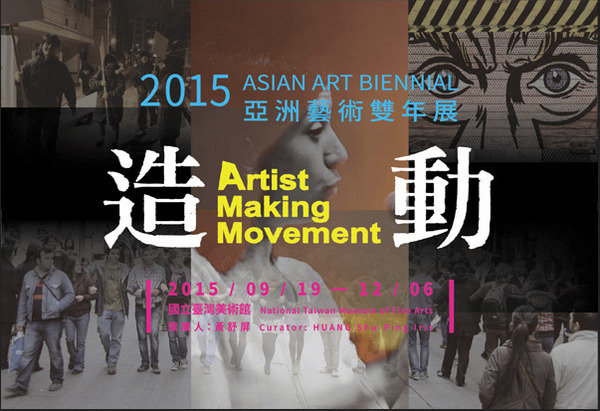Asian Art Biennial 2015
dal 19/9/2015 al 5/12/2015
Segnalato da
Irwan Ahmett
Tita Salina
Ayad Alkadhi
Poklong Anading
Brook Andrew
Rina Banerjee
Chou Yu-Cheng
Daar
Atul Dodiya
Hu Xiangqian
Anurendra Jegadeva
Teppei Kaneuji
Sachiko Kazama
Sutee Kunavichayanont
Jompet Kuswidananto
Sun k. Kwak
Lee Kai Chung
Iee Wen
Nguyen Trinh Thi
Okin Collective
Raquel Ormella
Alwin Reamillo
Su Wong-Shen
Studio Revolt
Sun Xun
Stephanie Syjuco
Spichatpong Weerasethakul
Yao Jui-Chung
Zhang Xu Zhan
Iris Shu-Ping Huang
19/9/2015
Asian Art Biennial 2015
National Taiwan Museum of Fine Arts, Taiwan
Artist Making Movement. The 5th Asian Art Biennial shows 140 works by 28 artists and groups from 17 areas/countries across Asia, featuring the wonderful diversity of contemporary Asian art, including painting, sculpture, installation, sound, video, performance art and workshop.

curated by Iris Shu-Ping Huang
The Asian Art Biennial was first organized by National Taiwan Museum of Fine Arts in 2007. Over the years, the event has adopted a theme-oriented approach to showcase a wide range of observations on contemporary social phenomenon and aesthetic issues in Asia. It has also encouraged artists to discuss the dramatic changes and developments in Asian culture in the face of globalization. The biennial highlights the interaction between Taiwan and Asia and seeks to create a platform for an Asian perspective of the world. It is hoped that this will promote discourse and sharing among the richly diverse elements of Asian culture and the many excellent art groups in the area.
The theme for the 2015 Asian Art Biennial is “Artist Making Movement” and the exhibition is curated by Iris Shu Ping Huang from the museum Exhibition Department. This subject matter reflects the current sense of discomfort in Asia and the trend for artists to break through the status quo via actions in their creative work. If we review art and creative types over the past few years, Asian artists have increasingly reflected social realities and focused more on local history, immersing themselves in important contemporary issues in Asia. In this context, artists are paying more attention to their own role, socially-oriented work and public responsibility, having concluded that ineffective public mechanisms make personalized creative energy more important than ever. These trends energetically reflect the personal values of a new era, wherein artists seek to kick start public interaction through perceptual works and seize opportunities for “qualitative change.” This represents the ongoing reflection and creation of new Asian culture, which reflects the sense of expectation and action as the people of Asia embrace a positive vision of their future.
The 5th Asian Art Biennial shows 140 works by 28 artists and groups from 17 areas/countries across Asia, featuring the wonderful diversity of contemporary Asian art, including painting, sculpture, installation, sound, video, performance art and workshop. The exhibition has three sub-themes “Crossover and Mobility”, “Archives and Memories” and “Public Awareness and Micro-Movements”, all of which address the aesthetic significance and creative vision of the “Artist Making Movement” theme. During the biennial, National Taiwan Museum of Fine Arts will also invite renowned experts in the field of Asian art to Taiwan to take part in a series of seminars. This is part of an effort to encourage greater interaction between local artistic views and broader Asia-wide trends, in the hope that Taiwan can play a more active role in the collective debate on the diversity of Asian culture.
National Taiwan Museum of Fine Arts has organized the Asian Art Biennial for eight years, each edition taking on a different theme and point of view. The biennial also invites internationally recognized artists, art historians and critics to Taiwan to engage in a wide ranging discussion on new trends and hot topics in contemporary Asian art. It is our hope that this combination of art exhibition and seminars will facilitate an artistic gathering, interaction and dialogue. We also very much hope that the Asian Art Biennial will spur long-term research into Asian art and culture, allowing the museum to further burnish its reputation in the field of Asian art curation, research and promotion. Finally, on behalf of the National Taiwan Museum of Fine Arts, I would like to take this opportunity to thank all the participating artists and to express our gratitude to all those institutions and agencies that lent works to make the Asian Art Biennial a great success.
Press office:
Emily Wang, T +886 4 2372 3552 #133 / emily.w@art.ntmofa.gov.tw
Asian Art and Curator’s Forum: September 20
National Taiwan Museum of Fine Arts
No.2, Sec. 1,Wuquan W. Rd. West District,Taichung, Taiwan, 403
Hours:
Tuesday–Friday 9–17h
Saturday–Sunday 9–18h



